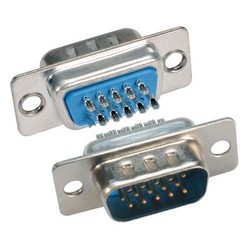Serial communication once reigned supreme. It used to be one of the most popular ways to connect peripherals such as printers, scanners, mice and joysticks to PCs. The most common connector type for serial communication was the D-Subminiature connector, also called D-sub. Though they have been replaced in some applications, D-Sub connectors are still relevant and used in many ways today.
Here are 9 things you need to know about D-subminiature connectors:
- D-Subminiature connectors were once among the smallest connectors used on computer systems. They are named for their D-shaped metal connector shell. The metal shell surrounds two or more parallel rows of pins or sockets that carry the data in series.
- There are five different connector shell sizes. Each shell size can have two different configurations of pins. The standard shell size has two rows of pins, and the high-density versions have three rows of pins.
-
With individual pins to carry serial data, D-sub connectors are very easy to customize. The DB9 connector is one of the standard configurations and has the smallest shell size, with 9 pins in the shell and measuring 1.3cm tall and 3.1cm wide. The largest, high-density configuration is HD78, with 78 pins it measures 1.5cm tall and 6.7cm wide.
-
Cables using D-sub connectors can cover much longer lengths than other cables. RS-232, the current common standard for serial data, does not have a defined length limit and RS-422 can be used over hundreds of meters with special equipment. On the other hand, USB has a length limit of five meters.
-
Serial communication tends to be slow, especially over long lengths. Breaks in communication can cause software on a PC to freeze unexpectedly.
-
D-Sub connectors are large, especially when compared to newer connector designs. This makes them difficult to connect and disconnect in tight spaces. Though right-angle adapters help in small spaces by allowing a right-angle bend without damaging the connector.
-
Because the pins are exposed on these connectors, they can be easily bent or broken off in the shell. The best way to avoid broken pins is to use a D-Sub plug or jack cover to protect the pins from being damaged when not mated. Also, gender changers and socket savers can help reduce stress from repeated mating cycles.
-
D-subminiature connectors can be mated without thumbscrews but a friction-fit it does not always hold. Using thumbscrews makes for a more secure connection, but it does take longer to plug and unplug the connector.
-
There are still many devices with DB9 ports and plenty of conversion options for legacy D-sub connectorized products. Converters to and from RS232/422/485 to USB, Ethernet and other technologies allow you to use your old serial device with many of today’s computers.
Explore our wide range of in-stock D-Sub connectors.


